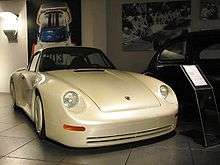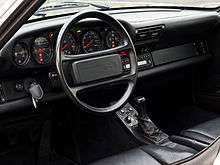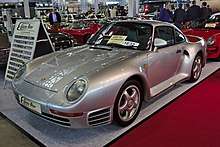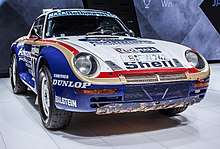Porsche 959
| Porsche 959 | |
|---|---|
%2C_21._M%C3%A4rz_2013%2C_D%C3%BCsseldorf.jpg) | |
| Overview | |
| Manufacturer | Porsche AG |
| Production |
1986–1988 & 1992–1993 (337+8 produced)[1] |
| Designer | Helmuth Bott[2] |
| Body and chassis | |
| Class | Sports car (S) |
| Body style | 2-door coupé |
| Layout | Rear-engine, four-wheel-drive |
| Related |
Porsche 911 Porsche 930 Porsche 961 Porsche 969 |
| Powertrain | |
| Engine | 2.8 L (2,849 cc) Twin-turbocharged flat-6 |
| Power output | 450 PS (331 kW; 444 bhp) and 500 N⋅m (369 lbf⋅ft) of torque |
| Transmission | 6-speed manual |
| Dimensions | |
| Wheelbase | 2,272 mm (89.4 in) |
| Length | 4,260 mm (168 in) |
| Width | 1,840 mm (72 in) |
| Height | 1,280 mm (50 in) |
| Curb weight | 1,450 kg (3,200 lb) |
| Chronology | |
| Successor | Porsche Carrera GT |
The Porsche 959 is a sports car manufactured by German car manufacturer Porsche from 1986 to 1993, first as a Group B rally car and later as a road legal production car designed to satisfy FIA homologation regulations requiring at least 200 units be produced.[3]
_in_Belgravia_on_2012-03-01.jpg)
The twin-turbocharged 959 was the world's fastest street-legal production car when introduced, achieving a top speed of 197 mph (317 km/h), with some variants even capable of achieving 211 mph (339 km/h). During its production run, the 959 was considered as the most technologically advanced road-going sports car ever built, and forerunner of all forthcoming sports cars. It was one of the first high-performance vehicles with all-wheel drive, providing the basis for Porsche's first all-wheel drive 911 Carrera 4 model. Its performance convinced Porsche executives to make all-wheel drive standard on all turbocharged versions of the 911 starting with the 993. The twin-turbo system utilised on the 959 also made its way to future turbocharged Porsche sports cars. In 2004, Sports Car International named the 959 number one on its list of Top Sports Cars of the 1980s.
History
.jpg)
.jpg)

Development of the 959 (originally called the Gruppe B) started in 1981, shortly after the company's then-new Managing Director, Peter Schutz, took his office. Porsche's chief engineer at the time, Helmuth Bott, approached Schutz with some ideas about the Porsche 911, or more aptly, a new one. Bott knew that the company needed a sports car that they could continue to rely on for years to come and that could be developed as time went on. Curious as to how much they could do with the rear-engined 911, Bott convinced Schutz that development tests should take place, and even proposed researching a new all wheel drive system. Schutz agreed, and gave the project the green light. Bott also knew through experience that a racing program usually helped to accelerate the development of new models. Seeing Group B rally racing as the perfect arena to test the new development mule and its all wheel drive system, Bott again went to Schutz and got the approval to develop a car, based on his development mule, for competition in Group B.

The powerplant was a sequential twin-turbocharged flat-six engine DOHC 4 valves per cylinder, fuel fed by Bosch Motronic 2.1 fuel injection with air-cooled cylinders and water-cooled heads, with a bore x stroke of 95 mm × 67 mm (3.74 in × 2.64 in) for a total displacement of 2,849 cc (173.9 cu in). It was coupled to a unique manual transmission offering five forward speeds plus a "gelände" (terrain) off-road gear, as well as reverse. The engine was largely based on the 4-camshaft 24-valve powerplant used in the Porsche 956 and 962 race cars.[4] The water-cooled four-valve cylinder heads combined with the air-cooled cylinders and sequential turbochargers allowed Porsche to extract 450 PS (444 hp; 331 kW) at 6,500 rpm and 500 N⋅m (369 lb⋅ft) of torque at 5,000 rpm from the compact, efficient and rugged power unit.[5] The use of sequential twin turbochargers rather than the more usual identical turbochargers for each of the two cylinder banks allowed for smooth delivery of power across the engine speed band, in contrast to the abrupt on-off power characteristic that distinguished Porsche's other turbocharged engines of the period. The engine was used virtually unchanged, in the 959 road car as well.
To create a rugged, lightweight shell, Porsche adopted an aluminium and Aramid (Kevlar) composite for the body panels and chassis construction along with a Nomex floor, instead of the steel floor normally used on their production cars.[6] The vehicle's weight of 1,450 kg (3,197 lb) helped to achieve its high performance.

Porsche also developed the car's aerodynamics, which were designed to increase stability, as was the automatic ride-height adjustment that became available on the road car (961 race cars had a fixed suspension system). Its drag coefficient was as low as 0.31 and aerodynamic lift was eliminated completely.[4][7]
The 959 also featured Porsche-Steuer Kupplung (PSK) all-wheel-drive system. Capable of dynamically changing the torque distribution between the rear and front wheels in both normal and slip conditions, the PSK system gave the 959 the adaptability it needed both as a race car and as a "super" street car. Under hard acceleration, PSK could send as much as 80% of the available power to the rear wheels, helping make the most of the rear-traction bias that occurs at such times.[8] It could also vary the power bias depending on road surface and grip changes, helping maintain traction at all times. The dashboard featured gauges displaying the amount of rear differential slip as well as transmitted power to the front axle. The magnesium alloy wheels were unique, being hollow inside to form a sealed chamber contiguous with the tire and equipped with a built-in tire pressure monitoring system.[9]
The Porsche 959 was actually produced at Baur, not at the Porsche factory in Zuffenhausen, on an assembly line with Porsche inspectors overseeing the finished bodies. Most of Porsche's special order interior leather work was also done by the workers at Baur.
The 1983 Frankfurt Motor Show was chosen for the unveiling of the Porsche Group B prototype. Even in the closing hours of October 9, finishing touches were being applied to the car to go on display the next morning. After the first two prototypes, the bodywork was modified to include air vents in the front and rear wheel housings, as well as intake holes behind the doors. The first prototype receiving those modifications was code named "F3", and was destroyed in the first crash test.
The road version of the 959 debuted at the 1985 Frankfurt Motor Show as a 1986 model, but numerous issues delayed production by more than a year. The car was manufactured in two levels of trim, "Sport" and "Komfort", corresponding to the trim with more creauture comforts and a more track focused trim. First customer deliveries of the 959 street variant began in 1987, and the car debuted at a cost of US$225,000 each, still less than half what it cost Porsche to build each car. Production ended in 1988 with 292 959s from the assembly line. In total, 337 cars were built, including 37 prototypes and pre-production models.[1] At least one 959 and one 961 remain in the Porsche historic hall in Stuttgart, Germany.
In 1992/1993, Porsche built eight more 959s assembled from spare parts from the inventory at the manufacturing site in Zuffenhausen.[1] All eight were "Komfort" versions: four in red and four in silver. These cars were much more expensive (DM 747,500) than the earlier ones (DM 420,000). The later cars also featured a newly developed speed-sensitive damper system. The cars were sold to selected collectors after being driven by works personnel for some time[1] and are today by far the most sought-after 959s.
The 959 was not street legal in the United States prior to 1999 when the "Show or Display" law was passed, although an unknown number were imported via the "grey market" during the late 1980s as show pieces. During the model's development Porsche refused to provide the United States Department of Transportation with the four 959s they required for crash testing, and the car was never certified by the National Highway Traffic Safety Administration for street use in the U.S. In 2001, with the passage of "Show and Display", the crash test requirements were removed and importation of the 959 was allowed, assuming the car could meet the emissions standards applicable in 1987. The 959 could be fitted with a catalytic converter and a re-programmed computer which allowed it to meet those emissions requirements. As the 959 was pre-1996, it was not be required to pass any emissions testing: due to the fact that most 959s are now over 25 years old and are therefore completely legal for US importation, they were no longer required to comply with show and display laws.
Performance
Test results for the 959 "Sport" (450 PS):
- 0–60 mph (97 km/h): 3.6 s[10]
- 0–100 mph (161 km/h): 8.2 s[10]
- 0–100 km/h (62.1 mph): 3.7 s[11][12]
- 0–120 km/h (74.6 mph): 5.1 s[12][13]
- 0–140 km/h (87.0 mph): 6.3 s[12][13]
- 0–160 km/h (99.4 mph): 7.9 s[13]
- 0–180 km/h (111.8 mph): 9.6 s[13]
- 0–200 km/h (124.3 mph): 11.4 s[13]
- 0–400 m (1⁄4 mile): 11.8 s @ 202 km/h (126 mph)[13]
- 0–1 km: 21.6 s @ 245 km/h (152.2 mph)[11]
- Top Speed: 198 mph (319 km/h)[10]
Test results for the 959 "Komfort" version (450 PS):
- 0–30 mph (48 km/h): 1.5 s[14]
- 0–40 mph (64 km/h): 2.2 s[14]
- 0–50 mph (80 km/h): 2.9 s[14]
- 0–60 mph (97 km/h): 3.6 s[14]
- 0–70 mph (113 km/h): 4.8 s[14]
- 0–80 mph (129 km/h): 5.8 s[14]
- 0–90 mph (145 km/h): 7.1 s[14]
- 0–100 mph (161 km/h): 8.8 s[14]
- 0–110 mph (177 km/h): 10.4 s[14]
- 0–120 mph (193 km/h): 12.4 s[14]
- 0–130 mph (209 km/h): 15.9 s[14]
- 0–140 mph (225 km/h): 19.2 s[15]
- 0–150 mph (241 km/h): 22.5 s[15]
- 30 mph (48 km/h)-50 mph (80 km/h): 11.9 s, using 6th gear (~1786 rpm @ 50 mph)[14]
- 50 mph (80 km/h)-70 mph (113 km/h): 8.8 s, using 6th gear[14]
- Standing 1⁄4 mile (402m): 12.0 s @ 116 mph (187 km/h)[14]
- Braking 70-0 mph: 166 ft (113–0 km/h: 50 m)[14]
- Top speed: 197 mph (317 km/h)[10]
If desired, even more power was available to customer cars by Porsche. According to Paul Frère there was an optional 530 PS (390 kW; 523 hp) factory upgrade, with an increased top speed 209 mph (336 km/h) along with the 0–100 km/h (62 mph) acceleration time reduced to 3.4 seconds.[16]
Porsche 959S

The Porsche 959 S was a package available to the 959 "Sport" that increased power output to 515 PS (380 kW; 510 bhp) thus resulting in a top speed of 339 km/h (211 mph) as tested by Auto, Motor und Sport at the Nardò in 1988.[17][18]
Racing
When Porsche began development of the 959, it looked toward Group B racing as a road-racing laboratory with which to develop technology for production cars. When Group B became focused on rallying events, however, Porsche felt the relevance to production cars was greatly reduced, and the goal of the 959 project shifted to frank state-of-the-art, cost-no-object technological innovation.

In 1984, however, three 911s modified to 959 specifications (due to the requirement that Group B cars be based on production cars with at least 200 built) were used in the Paris-Dakar Rally, with Jacky Ickx the prime motivator. By 1985, the 959 rally variant was ready, but it experienced a disappointing start: all three cars failed to finish. However, in 1986, the 959 finished 1-2. The 959 was never seriously considered for a Group B Rally season; the cost of completing a full season far outweighed any technical information that would have been gained.
In 1986, the racing variant of the 959, the Porsche 961, made its debut at the 24 Hours of Le Mans. Driven by René Metge partnering Claude Ballot-Léna, it finished first in its class and 7th overall. It returned in 1987 but failed to finish after a spin (missed gear change) while in 11th place by Canadian/Dutch driver Kees Nierop of Vancouver. Upon re-joining the track, the car was observed on TV monitors in the Porsche pits to be on fire and the driver was told to stop and get out of the car. Sadly Nierop pulled over between marshal stations and this extra time taken to get to the car by the marshals allowed the fire to consume most of the rear end and destroy the car. Thus ending short-lived the career of the 961. It was later repaired and put on display at the Porsche Museum.
Canepa Design modifications
In 2003, Canepa Design initiated a 959 upgrade program. By making modifications to the 959's turbochargers, exhaust system and computer-control systems, Canepa enabled the 959 to pass emissions requirements (thereby making it street-legal in the United States). The new configuration allowed parallel turbo charging and simplified diagnostics. Canepa also modified the 959's lightweight magnesium wheels to allow tyres without the unique Dunlop Denloc bead. A modern Michelin high-performance tyres capable of handling the increased performance could then be mounted. The original RE71 tires were available in the U.S. and have always been more than capable of handling the power output of the 959.[19]
In April 2018, Canepa announced the Generation III package for the 959. The package includes the replacement of the standard sequential twin-turbo system with a pair of Borg Warner parallel twin-turbochargers, new wiring harness and a new engine control unit along with a new exhaust system and a new clutch to handle the extra power produced by the car. The package enables the engine to produce 569 kW (774 PS; 763 hp) and 861 N⋅m (635 lb⋅ft) of torque. The package also includes the replacement of the standard suspension system with an evolution of the 959 S' suspension system fitted with modern dampers and titanium springs for improved handling and ride-height along with new tyres. The headlamps are replaced with new Xenon headlamps, providing better illumination than the original units.
In addition to the package, Canepa also introduced a limited production of the 959 SC (Sport Canepa) limited to 50 cars. The 959 SC comes standard with the Generation III Canepa upgrade along with a body overhaul and a new paint-to-sample paint job according to the customer's desire that takes 500 hours to complete. The car also features a reworked leather interior which is complimented with a steering wheel having hand-stitched leather and a more modern sound system with the interior alone taking 300 hours to complete. The process starts with a standard 959 and its teardown to the chassis with every rusty part replaced and every component coated with zinc. The package costs in excess of US$2 million including the cost of the car itself.[20]
"Gates 959"
The "Gates 959" is an infamous 959 owned by Microsoft founder Bill Gates. Bill Gates bought his 959 before the model had Department of Transportation and Environmental Protection Agency approval. The "Gates 959" was stored for 13 years by the Customs Service at the Port of San Francisco, until regulations were changed to allow "Autos of Interest" to be imported with limitations on their use.[21] Gates helped pass the "Show or Display" law.[21][22][23]
Notes
- 1 2 3 4 Ludvigsen 2003, p. 1032.
- ↑ "Porsche 959, everything you need to know". Evo magazine. 6 May 2016. Retrieved 15 February 2018.
- ↑ Ludvigsen 2003, p. 1003.
- 1 2 https://www.roadandtrack.com/new-cars/first-drives/a26605/drive-flashback-1986-porsche-959/
- ↑ "1987/88 Porsche 959". Official website of Porsche.
- ↑ Ludvigsen 2003, p. 1009.
- ↑ Car and Driver July 1997 p.63-66 https://members.rennlist.com/951_racerx/Porsche959vs911TurboS.pdf
- ↑ Ludvigsen 2003, p. 1012.
- ↑ Ludvigsen 2003, p. 1011.
- 1 2 3 4 Road & Track July 1987. Excerpt: Egan, Peter (2016-05-29). "In 1987, The World's Fastest Cars Couldn't Catch A 211-mph Twin-Turbo Ruf". Road & Track. US. Retrieved 2016-08-26.
- 1 2 Auto, Motor und Sport 12/1987 (5 June 1987)
- 1 2 3 Article "De snelste:339 km/u!" by Paul Frère
- 1 2 3 4 5 6 Auto, Motor und Sport 2/2018 https://www.auto-motor-und-sport.de/test/porsche-959/
- 1 2 3 4 5 6 7 8 9 10 11 12 13 14 15 "Car and Driver November 1987" (PDF). Retrieved 29 January 2016.
- 1 2 Fast Lane June 1989
- ↑ Frère, Paul (1997). Porsche 911 Story. Patrick Stephens Limited (Haynes Publishing). p. 335. ISBN 1-85260-590-1.
- ↑ Auto, Motor und Sport 25/1988
- ↑ Bernd Woytal (18 October 2015). "Ferrari F40 gegen Porsche 959: Nonplusultra-Supersportler der 80er - Auto Motor und Sport". auto motor und sport.
- ↑ "Bridgestone RE71 Denloc". tirerack.com.
- ↑ Constantine, Chris (23 April 2018). "Bruce Canepa Announces 763-Horsepower Upgrade Package for the Porsche 959". The Drive. Retrieved 25 May 2018.
- 1 2 Stephan Wilkinson. The Gold-Plated Porsche. The Lyons Press, Guilford, Connecticut (2005) pages 21-2,
ISBN 1-59228-792-1. templatestyles stripmarker in
|publisher=at position 59 (help) - ↑ "How To Import A Motor Vehicle For Show Or Display". National Highway Traffic Safety Administration. 2003-07-07.
- ↑ Display of Speed: Under the "Show or Display exemption, Americans can now import previously forbidden exotics", January 7, 2001, autoweek.com
References
- Bowler, M. & Wood, J. (1997). The Fastest Cars from Around the World. Parragon. ISBN 0-7525-1022-3.
- Frère, P. (1999). Porsche 911 Story (sixth edition). Patrick Stevens Limited. ISBN 1-85260-590-1.
- Ludvigsen, Karl (2003). Porsche: Excellence Was Expected. 3. Cambridge, Massachusetts: Bentley Publishers. ISBN 0-8376-0235-1.
- Wood, J. (1997). Porsche: The Legend. Parragon. ISBN 0-7525-2072-5.
- Kim, Daniel (2015). Porsche 959: The Greatest Porsche of All-Time?
External links
| Wikimedia Commons has media related to Porsche 959. |
- "1986 Porsche 959". Dr. Ing. h.c. F. Porsche AG. Retrieved 2012-03-24.
- "1987/88 Porsche 959". Dr. Ing. h.c. F. Porsche AG. Retrieved 2012-03-24.
- "1987/88 Porsche 959". Dr. Ing. h.c. F. Porsche AG. Retrieved 2012-03-24.
Porsche road car timeline, 1948–1990s — next » | ||||||||||||||||||||||||||||||||||||||||||||||||||||
|---|---|---|---|---|---|---|---|---|---|---|---|---|---|---|---|---|---|---|---|---|---|---|---|---|---|---|---|---|---|---|---|---|---|---|---|---|---|---|---|---|---|---|---|---|---|---|---|---|---|---|---|---|
| Type | 1940s | 1950s | 1960s | 1970s | 1980s | 1990s | ||||||||||||||||||||||||||||||||||||||||||||||
| 8 | 9 | 0 | 1 | 2 | 3 | 4 | 5 | 6 | 7 | 8 | 9 | 0 | 1 | 2 | 3 | 4 | 5 | 6 | 7 | 8 | 9 | 0 | 1 | 2 | 3 | 4 | 5 | 6 | 7 | 8 | 9 | 0 | 1 | 2 | 3 | 4 | 5 | 6 | 7 | 8 | 9 | 0 | 1 | 2 | 3 | 4 | 5 | 6 | 7 | 8 | 9 | |
| Roadster & sports cars | 912 | 912E | 924 | Boxster (986) | ||||||||||||||||||||||||||||||||||||||||||||||||
| 356 | 914 | 944 | 968 | |||||||||||||||||||||||||||||||||||||||||||||||||
| 911 series | 911 | 911 / 930 | 911 (964) | 911 (993) | 911 (996) | |||||||||||||||||||||||||||||||||||||||||||||||
| GT | 928 | |||||||||||||||||||||||||||||||||||||||||||||||||||
| Supercar | 959 | 911 GT1 Straßenversion | ||||||||||||||||||||||||||||||||||||||||||||||||||